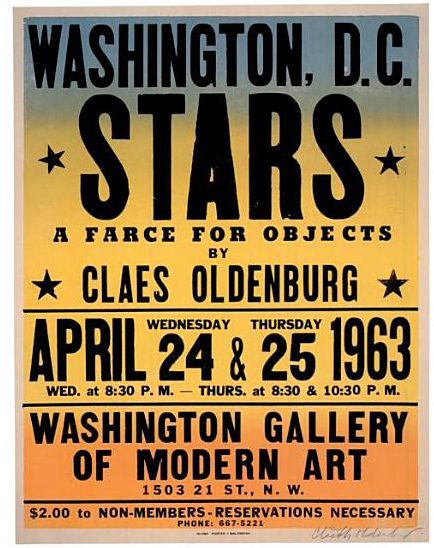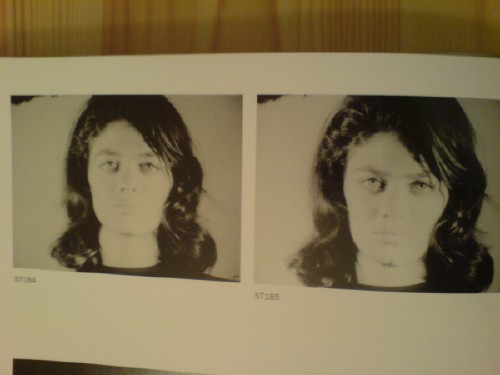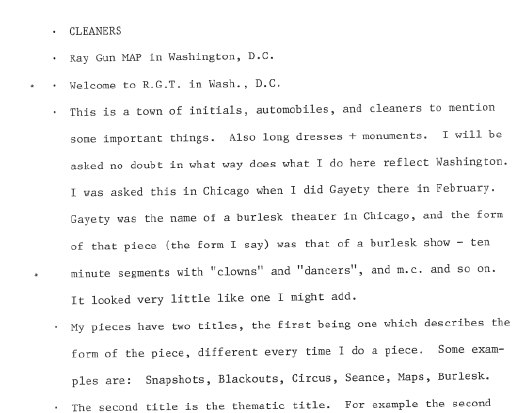
This explains the “two or three Happenings” discrepancies; there was a matinee Happening on Thursday.
Also: “Globe Poster – Baltimore.”
I’ve had this on my desktop so long, I’ve forgotten where I ganked it. Oh, that’s right, Oldenburg’s print poster & ephemera catalogue raisonne, Printed Stuff (1997).
Previously: What’s Happening? Claes Oldenburg’s Stars via Time and Alice Denney
What’s Happening? Tracking Stars, Claes Oldenburg’s 1963 Washington DC Happening
Tag: happening
In Xanadu Did Rauschenberg A Stately Parachute Deploy
It’s hard to say where the momentous awesomeness of the Washington Gallery of Modern Art’s 1963 Pop Art Festival first overwhelmed me.
When I learned that noted Pop Artist John Cage performed on opening night?
When I found out that Claes Oldenburg held an early Happening in the dry cleaners on P Street?
Or when I saw this picture from the gigantic dance extravaganza at the America on Wheels roller rink in Adams Morgan, organized by Billy Kluver, with Merce, Yvonne, and the Judson Dance Theatre?

That is Robert Rauschenberg, on roller skates, with a parachute on his back, premiering his dance, Pelican, a tribute/homage to his heroes, the Wright Brothers.
Rauschenberg had been doing costumes and set design for Cunningham’s company for many years, but when the program for the Pop Art Festival performance listed him as a choreographer, he decided to roll with it, so to speak.
Well, it turns out Cage’s performance was a lecture; Oldenburg’s Happening was moved to the gallery; and this photo of Pelican is from 1965, by which point, Rauschenberg had more than a couple of days’ skating practice. But still, the magic lives on every time I go to that roller rink, which is now a Harris Teeter.
Update: Holy smokes, SFMOMA has a film clip. That’s Rauschenberg, Per Olof Ultvedt, and Merce Cunningham dancer Carolyn Brown. The SI’s Eye Level blog has comments by Alice Denney on Rauschenberg’s DC forays.
image: Peter Moore, published in Mary Lynn Kotz’s 2004 Rauschenberg Art/Life, via warholstars.org
What’s Happening? Claes Oldenburg’s Stars Via Time And Alice Denney
I’ve already mentioned the May 3, 1963 Time Magazine article about the Washington Gallery of Modern Art’s Pop Art Festival; it’s really not much, but it contains the most extensive contemporary account of Claes Oldenburg’s 1963 Happening, Stars. Here’s how they reported the grand finale:
Red Gee String.
As the evening wore on, slides of naked women were projected, suggesting that pornography has its place among the neo-Palladian splendors of the alabaster city. Waiters spilled bits of plastic from trays onto the audience. A woman came on wearing a shredded American flag on her head; her spine was as stiff as a flagpole. It had to be, since it was part of the monument to the victory at Iwo Jima, and three soldiers held her at the appropriate tilt. A 14-year-old boy in a Lincolnesque beard entered the room, was shown to his seat, and sat there waiting to be shot. Zow.
For the closing number, Miss Washington, stacked like the melon gallery, appeared in a mass of red taffeta. She pulled her rip cord, and there she stood–after all, it is the nation’s capital–not quite nude. An aw-gee string. A suggestion of red taffeta there-there and there.
She turned and bolted like a moose, followed by official Washington, gurgling hip-hip for happenings.
All these activities map very closely to Oldenburg’s script, which was transcribed and published with his Raw Notes in 1971. But these incomplete accounts generate as many questions as they answer about how Stars took shape, what actually happened, and what happened afterward as a result.
I finally decided to go to the source. Last week I spoke with Alice Denney, who organized the Pop Art Festival and curated the Popular Image show it accompanied. She was generous and awesome, and not a little bemused at my questions–or that I was asking them at all.
How many Happenings were there? When and why did the site move from the cleaners to the Gallery, and how did that affect it?
AD: We thought we could do it in the rug cleaning place on P Street, but a few days before, a couple of the trustees came in and said, “You couldn’t do it there, there’s no egress.” So we moved it.
…
[The content] didn’t change, even though the space was much tighter. We used the stairway so that Olga Kluver could come down.
Ah, so Olga Kluver was the one in the red taffeta dress. In 1963, though she was living with Billy Kluver, she still went by Olga Adorno. Kluver, of course, had helped organize another major event for the Festival, a multi-stage dance performance by the Judson folks at a roller skating rink in Adams Morgan. Meanwhile, in 1964, Andy Warhol threw a party to celebrate Adorno and Kluver’s marriage.

Adorno appeared in at two of Warhol’s Screen Tests, ST184 and ST185, both in 1964. She also performed in Happenings by Allan Kaprow, Red Grooms, and Robert Whitman. Apparently, Adorno’s still going strong, creating enigmatic performance works from her base in Nice, France. But back to Mrs Denney, who was the gallery staffer mentioned in Time as making blue ice cream and serving it on picnic plates, and whose son was the stand-in for Lincoln:
…It was all about Washington: the monuments, the dinner parties…
Everybody wanted to go, and all the fancy folks wanted to be in it.
But it was pretty much my gang of crazies, [Claes] didn’t want society ladies.
And it turned out to be quite popular. The reservations filled right up for all three Happenings [one on Wed., Apr 24, and two on the 25th]. Mrs Denney mentioned that in addition to performing in Stars, Claes’s first wife, Patty [Pat Muschinski], worked on many of Oldenburg’s soft sculptures and costumes, and wrote a memoir of the Happening for Art in America. And so the chain continues.
What’s Happening? Nina Burleigh Takes On Claes Oldenburg
In her 1998 biography of Mary Pinchot Meyer, Nina Burleigh used Stars, Claes Oldenburg’s Happening at the Washington Gallery of Modern Art’s 1963 Pop Art Festival, as a bellwether for sophisticated Georgetown/Washington’s temperament towards contemporary art. Here’s how Burleigh described the event [from p. 202]:
Stars: A Farce for Objects Designed by Claes Oldenburg and involving twenty-one players, the happening lampooned official Washington and satirized the capital’s iconography. One pieces was a huge sewn miniature of the Washington Monument moving around by means of seven people huddled inside. One scene involved a very well-endowed naked woman coming down some steps, and included such absurdities as a roller skater, a waiter carrying a tray and spilling colored foam rubber bits, a girl brushing her teeth, two men spraying room deodorant, a woman undulating inside two mattresses, a girl ironing, and a child dishing out blue frosting. It was accompanied by drumbeats and a rendition of “Sweet Leilani.” Each action was repeated twenty-four times. It was received with annoyance by the art critic for the Washington Evening Star, who found the whole evening tedious. The show, he wrote, “will be repeated and repeated and repeated tonight.”
What’s Happening? Tracking Stars, Claes Oldenburg’s 1963 Washington DC Happening

It’s been a few months, and now I’ve been researching it so many places, I can’t remember exactly where I first discovered that Claes Oldenburg did a Happening in Washington DC. And an early one, too. He was invited by Alice Denney, the assistant director of the fledgling Washington Gallery of Modern Art, for The Pop Art Festival she was organizing alongside her pioneering show of Pop Art, “The Popular Image Exhibition,” which opened in April 1963.
Pop was still barely being defined. By including a lecture/tape recorder performance by John Cage and a multi-ring dance event organized by Billy Kluver and featuring Yvonne Rainer and the Judson Church crew, Denney’s expansive view seems to have equated Pop with early 60s avant-garde. If there’s a thread that persisted, it was the artists’ engagement with the popular culture, in contrast to the prevalent self-referential mode of Abstract Expressionists. [The WGMA had just opened with the first Franz Kline retrospective.]
Anyway, it’s a bear trying to find out what this Happening was all about. There was one, there were two. It/they happened at a rug cleaners off of Dupont Circle, and/or in the Gallery itself. It was called Stars and/or Cleaners.
The confusion is partly the ephemeral, had-to-be-there nature of the medium, and partly the fragmented, subjective nature of the accounts I’ve collected so far. Whether written in anticipation of the event or in its aftermath, PR-excited or cynical, they’re incomplete and/or inconsistent. And none is definitive or gives a clear picture of Oldenburg’s intentions or plans, or even what happened. And of course, there are few-to-no substantive reviews.
And then there’s the art historical blind spot that DC inhabits in the art world, and that the art world inhabits in DC. [The Kennedy era seems to be one of the few times that official Washington seemed interested, not just in contemporary art, but in art as it was happening. And that obviously didn’t last, though the institutional vestiges of Camelot and the WGMA linger on, from the NEA to the Art In Embassies program to the Washington Project for the Arts, which is on its third or fourth life right now under my friend Lisa Gold.]
So rather than just write up some mega-post posing as an MFA thesis, I’m going to post an anthology/bibliography for Stars, which will include the articles and accounts I’ve found, plus some interviews I’m doing with folks who were involved with the Happening itself. I’ll keep this post updated with links as I go:
Claes Oldenburg: Raw Notes (1973) contains “Documents and scripts for the performances: Stars, Moneyhouse, Massage, The Typewriter, with annotations by the author. It was republished in 2005.
It turns out Stars was originally called Cleaners, after its first chosen/intended venue. The dates were April 23 & 24, 1963:
This is a town of initials, automobiles and cleaners to mention some important things. Also long dresses + monuments. I will be asked no doubt in what way does what i do here reflect Washington…
My pieces have two titles, the first being one which describes the form of the piece…The second title is the thematic title.
Oldenburg selected Aristo Rug Cleaners, located on P Street around the corner from the WGMA. His notes mention the activity of the site, and how “the interaction of white shirts and brown and black (employees)” embodied the city itself.
After a visit to Washington for the purpose of using the place [the cleaners], I did form the title STARS, already more specific than the first stage. This came from seeing very clear stars in the sky on the last moment of my visit and seemed to concentrate certain physical properties of the place, f. ex. the patriotic motif. The radiated way the streets are built. But the title was still abstract in that it was achieved part from a particular place in Wash. where the piece might be done.
Then Oldenburg set out to design the event, collect props, and cast all his players during a two-week preparatory visit. Next up will be a friendly preview of the performance from that prep period by Washington Post columnist Art Buchwald.
